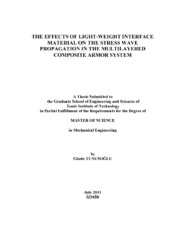Please use this identifier to cite or link to this item:
https://hdl.handle.net/11147/3109| Title: | The effects of light-weight interface material on the stress wave propagation in the multilayered composite armor system | Authors: | Tunusoğlu, Gözde | Advisors: | Taşdemirci, Alper | Publisher: | Izmir Institute of Technology | Abstract: | The main purpose of the current study is to investigate the effect of interlayer material on the ballistic performance of composite armor and stress wave propagation both experimentally and numerically. Three different interlayer materials, EPDM rubber, Teflon and Aluminum metallic foam, were tried. Relatively large pieces of the ceramic around the impact axis in the rubber interlayer configuration were observed while the ceramic layer was efficiently fragmented in Aluminum foam and Teflon interlayer configurations. Accordingly, more significant amount of delamination in composite layer of without interlayer, larger and deeper delamination in EPDM rubber configurations was observed while fewer amounts were observed on Teflon and Aluminum foam configurations .Also, all interlayers caused reduction in the magnitude of the stress transmitted to the composite backing plate, particularly Aluminum foam. However, EPDM rubber did not cause delay in the initial stress build-up in the composite layer, whereas Teflon (~15 ms) and Aluminum foam (~25 ms) caused a significant delay. Also, as ceramic was efficiently fragmented in Teflon and Aluminum metallic foam interlayer configurations, greater amount of projectile kinetic energy was absorbed in this layer, as a consequence, the remaining energy which was transmitted to composite backing plate was decreased. At this point, the effectiveness of Aluminum foam and Teflon were validated with conducting ballistic tests and corresponding numerical simulations and impact chamber tests. After this validation, the ballistic performance of aforementioned materials was compared at equal areal densities. Finally, Aluminum foam was found to be more effective interlayers in reducing the stress values transmitted to the composite backing plate and reduction of the damage imparted to this layer. | Description: | Thesis (Master)--Izmir Institute of Technology, Mechanical Engineering, Izmir, 2011 Includes bibliographical references (leaves: 112-117) Text in English; Abstract: Turkish and English xiii, 117 leaves |
URI: | http://hdl.handle.net/11147/3109 |
| Appears in Collections: | Master Degree / Yüksek Lisans Tezleri |
Files in This Item:
| File | Description | Size | Format | |
|---|---|---|---|---|
| T000925.pdf | MasterThesis | 25.8 MB | Adobe PDF |  View/Open |
CORE Recommender
Page view(s)
90
checked on Jul 22, 2024
Download(s)
224
checked on Jul 22, 2024
Google ScholarTM
Check
Items in GCRIS Repository are protected by copyright, with all rights reserved, unless otherwise indicated.